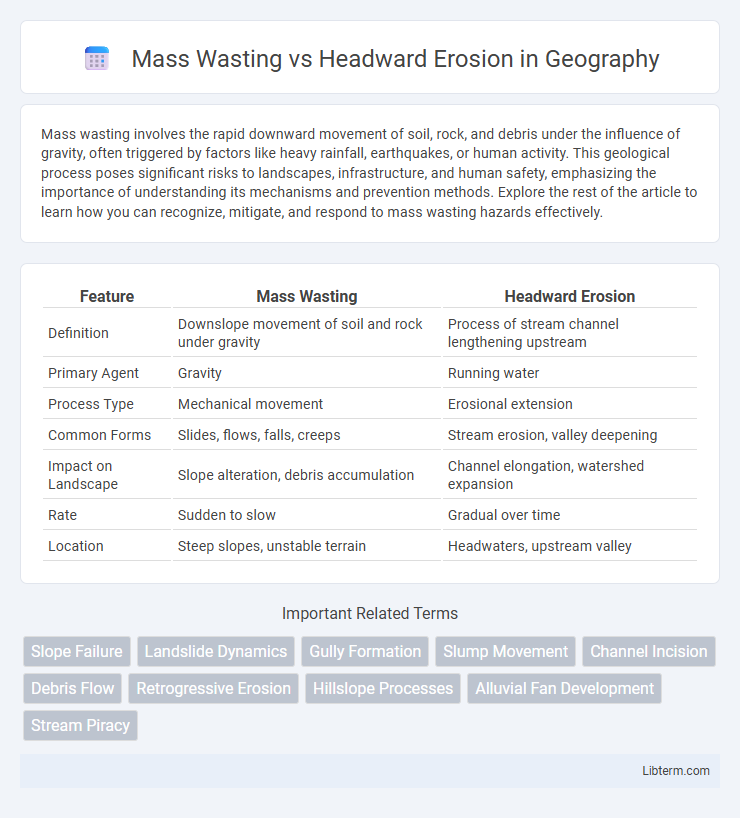Mass wasting involves the rapid downward movement of soil, rock, and debris under the influence of gravity, often triggered by factors like heavy rainfall, earthquakes, or human activity. This geological process poses significant risks to landscapes, infrastructure, and human safety, emphasizing the importance of understanding its mechanisms and prevention methods. Explore the rest of the article to learn how you can recognize, mitigate, and respond to mass wasting hazards effectively.
Table of Comparison
| Feature | Mass Wasting | Headward Erosion |
|---|---|---|
| Definition | Downslope movement of soil and rock under gravity | Process of stream channel lengthening upstream |
| Primary Agent | Gravity | Running water |
| Process Type | Mechanical movement | Erosional extension |
| Common Forms | Slides, flows, falls, creeps | Stream erosion, valley deepening |
| Impact on Landscape | Slope alteration, debris accumulation | Channel elongation, watershed expansion |
| Rate | Sudden to slow | Gradual over time |
| Location | Steep slopes, unstable terrain | Headwaters, upstream valley |
Introduction to Mass Wasting and Headward Erosion
Mass wasting involves the downslope movement of soil, rock, and debris under the influence of gravity, significantly shaping landscapes by altering slopes and causing sediment displacement. Headward erosion refers to the upstream extension of a stream channel's source, gradually lengthening the drainage basin and contributing to valley formation. Both processes are fundamental to geomorphology, affecting landform evolution through soil displacement and channel development.
Defining Mass Wasting: Processes and Types
Mass wasting refers to the downhill movement of soil, rock, and debris under the influence of gravity, encompassing processes such as landslides, rockfalls, mudflows, and creep. These processes vary in speed and moisture content, ranging from rapid rock avalanches to slow soil creep, all contributing to landscape alteration. Understanding mass wasting is crucial for hazard assessment and land management in mountainous and unstable terrain.
Understanding Headward Erosion: Mechanisms and Effects
Headward erosion is the process by which a stream channel lengthens at its origin, caused by the removal of soil and rock from the head of the stream. This mechanism primarily involves hydraulic action and abrasion, where flowing water dislodges particles and transports them downstream, gradually extending the channel upstream. The effects of headward erosion include the expansion of drainage basins, alteration of watershed boundaries, and increased sediment supply to downstream environments.
Key Differences Between Mass Wasting and Headward Erosion
Mass wasting involves the downslope movement of soil and rock due to gravity, while headward erosion refers to the lengthening of a stream or river channel upstream through the removal of soil and rock. Mass wasting primarily reshapes slopes and can cause landslides, rockfalls, and debris flows, whereas headward erosion contributes to stream valley extension and watershed expansion. Key differences include the mechanism of material transport--gravity-driven mass movement versus water-driven erosion--and the impact on landscape morphology, with mass wasting altering slope stability and headward erosion advancing channel development.
Geological Factors Influencing Mass Wasting
Mass wasting is primarily influenced by geological factors such as rock type, slope angle, and soil composition, which determine the material's stability and susceptibility to gravitational movement. Clay-rich soils and fractured bedrock increase the likelihood of landslides, while steep slopes amplify the gravitational force driving mass wasting events. In contrast, headward erosion is driven by fluvial processes and focuses on the extension of a stream channel, with less direct dependence on soil cohesion and slope material properties.
Environmental Conditions Driving Headward Erosion
Headward erosion is primarily driven by environmental factors such as water flow velocity, soil type, and rainfall intensity, which promote the upstream extension of a stream channel. Unlike mass wasting, which depends on gravity and slope stability, headward erosion is influenced by hydrological processes that increase runoff and sediment transport. Vegetation cover and land use changes also affect infiltration rates and surface runoff, accelerating the headward erosion process.
Impacts on Landscape Evolution: Mass Wasting vs Headward Erosion
Mass wasting reshapes landscapes by rapidly moving large volumes of soil and rock downslope, often triggering slope failures and altering topography abruptly. Headward erosion extends stream channels upslope, gradually lengthening valleys and enhancing drainage networks over time. Together, these processes drive landscape evolution through contrasting mechanisms: mass wasting delivers immediate morphological change, while headward erosion promotes slow, persistent valley expansion.
Common Examples and Case Studies
Mass wasting commonly manifests through landslides, rockfalls, and debris flows, with notable case studies including the 2014 Oso landslide in Washington, which caused significant destruction and loss of life. Headward erosion predominantly occurs in river systems and is exemplified by the rapid creek channel extension observed in the Grand Canyon's tributaries, accelerating valley formation. Both processes significantly contribute to landscape evolution but operate through distinct mechanisms: mass wasting involves gravity-driven material movement, while headward erosion is driven by water flow eroding the origin of stream channels.
Human Activities Affecting Mass Wasting and Headward Erosion
Human activities such as deforestation, construction, and mining significantly increase the risk of mass wasting by destabilizing soil and rock on slopes. Agricultural practices and urban development exacerbate headward erosion by accelerating runoff and removing vegetation that normally protects soil from erosion. Effective land management and erosion control measures are crucial to mitigate the impacts of human-induced mass wasting and headward erosion.
Mitigation and Management Strategies
Mass wasting mitigation involves stabilizing slopes through retaining walls, terracing, and vegetation to reduce soil erosion and prevent landslides. Headward erosion management emphasizes controlling water flow with proper drainage systems, riprap installations, and maintaining vegetation buffers to slow down stream bank retreat. Both strategies require continuous monitoring and engineering interventions to minimize environmental impacts and protect infrastructure.
Mass Wasting Infographic

 libterm.com
libterm.com